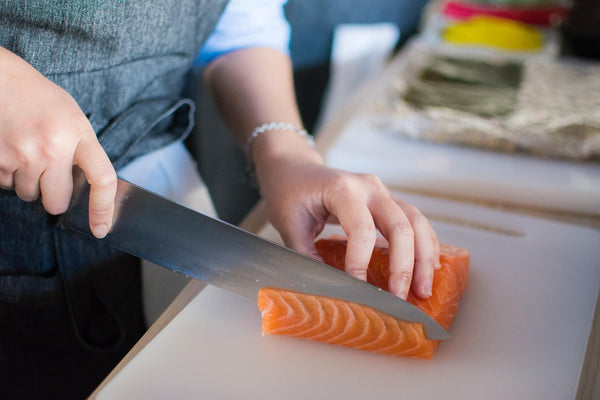How Much Protein is in Salmon?
Updated on Jul 05, 2023
When it comes to nutrient-packed foods, few options rival the remarkable protein content of salmon. Renowned for its delicious taste and numerous health benefits, salmon stands out as an exceptional source of high-quality protein.
Whether you are a health enthusiast, an athlete seeking muscle recovery, or simply curious about the protein composition of this popular fish, prepare to discover the bountiful protein treasures that salmon has to offer.
Protein Content in Salmon
The amount of protein in salmon depends on your serving size. Half a typical salmon fillet contains roughly 39 grams of protein, with 46% of its calories derived from protein.
100 grams of wild salmon contains roughly 25 grams of protein, while the same amount of farmed salmon contains about 22 grams.
Factors Influencing Protein Content in Salmon
Several factors can influence the protein content in salmon. These factors include:
- Wild-caught vs. farm-raised salmon: Wild-caught salmon typically contains more protein than farm-raised salmon thanks to a varied diet of smaller fish and other marine organisms. By comparison, farm-rasied salmon have controlled diets, some of which contain dyes and pesticides.[*]
- Age and size: Larger and older salmon tend to have higher protein levels. As salmon grow and mature, their protein content increases along with their overall size.
- Location and habitat: Salmon living in nutrient-rich and diverse marine environments tend to have access to a wider range of food sources, contributing to higher protein content. Factors such as water temperature, salinity, and the availability of prey can influence protein levels.
Protein Content in Salmon According to Types
Different types of salmon may vary slightly in their protein content. Here's an overview of the protein content in three commonly consumed types of salmon:
| Type of Salmon | Protein Content (Per 3.5 oz) |
| Atlantic | 20-22g |
| Chinook | 22-25g |
| Sockeye | 22-25g |
While there may be slight variations in protein content among different types of salmon, these three types mentioned above are excellent sources of high-quality protein. They contribute to meeting daily protein requirements and offer a range of other health benefits through their nutrient profiles, including omega-3 fatty acids and various vitamins and minerals.[*, opens in a new tab]
Protein Content in Salmon According to Cuts
No two cuts of salmon boast the same protein content. Consider the various available salmon cuts and how much protein you can obtain from a single serving.[*, opens in a new tab]
| Salmon Cut | Protein Content |
| Salmon Fillet (396g) | 80g |
| Salmon Steak (100g) | 20g |
| Salmon Side (100g) | 23.6g |
| Salmon Sashimi (100g) | 20-25g |
A typical serving of salmon is 100 grams, or 3.5 ounces. As such, most expert measure in servings instead of calculating the protein in salmon per ounce.
FAQs
Does cooking salmon affect its protein content?
Yes, how you cook salmon can affect its protein content. Steamed and oven-cooked salmon, for instance, has a higher protein content than boiled and raw salmon.[*, (opens in new tab)]
Depending on the heat applied, specific cooking methods can affect salmon’s nutritional value, resulting in vitamin loss and fat breakdown.
What is the recommended serving size of salmon to get an adequate amount of protein?
The body requires protein to build and repair muscle – a benefit you can derive from the protein in salmon. For optimal health and recovery, research suggests consuming at least 20 to 30 grams of protein, or no less than one serving of salmon.[*, (opens in new tab)]
Learn more about the health benefits of salmon in our guide.
How does the protein content in salmon compare to other types of fish?
While salmon has a high amount of protein, fresh tuna has the highest amount per gram of any fish, with 30.7 g of protein in a single 100-gram serving. Still, you can get the necessary required amount of protein per day from salmon.[*(opens in a new window)]
If you’re considering other types of fish, refer to our article about the best fish to eat for optimal health.
Summary
The protein in salmon is truly a force to be reckoned with. With its impressive protein content, salmon emerges as a nutritional powerhouse that can support muscle growth, aid in recovery, and contribute to overall health. Regardless of your culinary preferences, rest assured that each ounce of this remarkable fish delivers a substantial dose of protein, making it a valuable addition to any balanced diet.
If you're after the finest salmon, our wild sockeye salmon and wild king salmon are excellent choices. From Alaska's pristine waters, this premium fish combines rich flavor with outstanding nutrition!
References:
- FoodData Central. Usda.gov. Published 2023. Accessed July 3, 2023. https://fdc.nal.usda.gov/fdc-app.html#/food-details/175168/nutrients
- Colombo SM, Mazal X. Investigation of the nutritional composition of different types of salmon available to Canadian consumers. 2020;2:100056-100056. doi:https://doi.org/10.1016/j.jafr.2020.100056
- Nidelle Sausten Fomena Temgoua, Sun Z, Charles Obinwanne Okoye, Pan H. Fatty Acid Profile, Physicochemical Composition, and Sensory Properties of Atlantic Salmon Fish (Salmo salar) during Different Culinary Treatments. 2022;2022:1-16. doi:https://doi.org/10.1155/2022/7425142
- Richter M, Baerlocher K, Bauer JM, et al. Revised Reference Values for the Intake of Protein. 2019;74(3):242-250. doi:https://doi.org/10.1159/000499374
- Hardy RW. Alternate protein sources for salmon and trout diets. 1996;59(1-3):71-80. doi:https://doi.org/10.1016/0377-8401(95)00888-8








